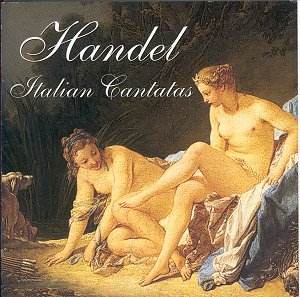Handel spent more than three years in Italy between
1706 and 1710, where he perfected his technique in setting Italian
words to music. Throughout his creative life he remained strongly
attached to the Italian Baroque style, much admired and imitated
in 18th Century Europe, and was acquainted with some
of its finest singers, notably the castrato Senesino and soprano
Curzoni. This two-CD set contains six of the 25 solo and duo secular
cantatas Handel wrote for performance in the great houses of the
aristocracy and church hierarchy where eminent singers and instrumentalists
were doubtless available. Though similar to the 17th
century cantatas of Carissimi, Alessandro Scarlatti, Stradella
and others the sound is distinctively Handelian and the themes
are concerned mainly with various aspects of romantic love.
This is an attractive set, with excellent singers
and responsive instrumentalists. However the nettle must be grasped:
these cantatas almost certainly do not sound as they did when
first heard, with Corelli playing the violin and conducting. Apart
from anything else, his was almost certainly a smaller ensemble.
Thus if the present-day penchant for ‘historically informed’ performance
on original instruments is more than a passing fad or fashion
(which I do not believe to be so) we are left in something of
a quandary as to the authenticity of these performances. The 17th
and 18th century secular cantata, though smaller in
scale, was essentially what we might call ‘music theatre’. While
the opening instrumental tutti of Delirio amoroso strikes
the required theatrical note, here it sounds more like English
19th century opera than Italian chamber music. Instruments
have an important role throughout, but there are times when both
Concerto Armonico and Capella Savaria swamp what the singers are
trying to express, which is mainly tender, deeply-felt emotion.
Despite these reservations there is much to admire.
Mária Zadori and the countertenor Ralf Popken have clearly
immersed themselves in the Italian ritornello style, with its
delicacy of ornamentation and expressive nuances. They almost
(but not quite) rescue these discs from becoming an exercise in
antique reproduction. My suggestion for auditioning this set would
be to listen to CD 2 first, since it contains the most interesting
cantatas, and the singing is of the highest quality throughout.
Unusually for Brilliant Classics it comes with a highly informative
20pp booklet.
Roy Brewer
